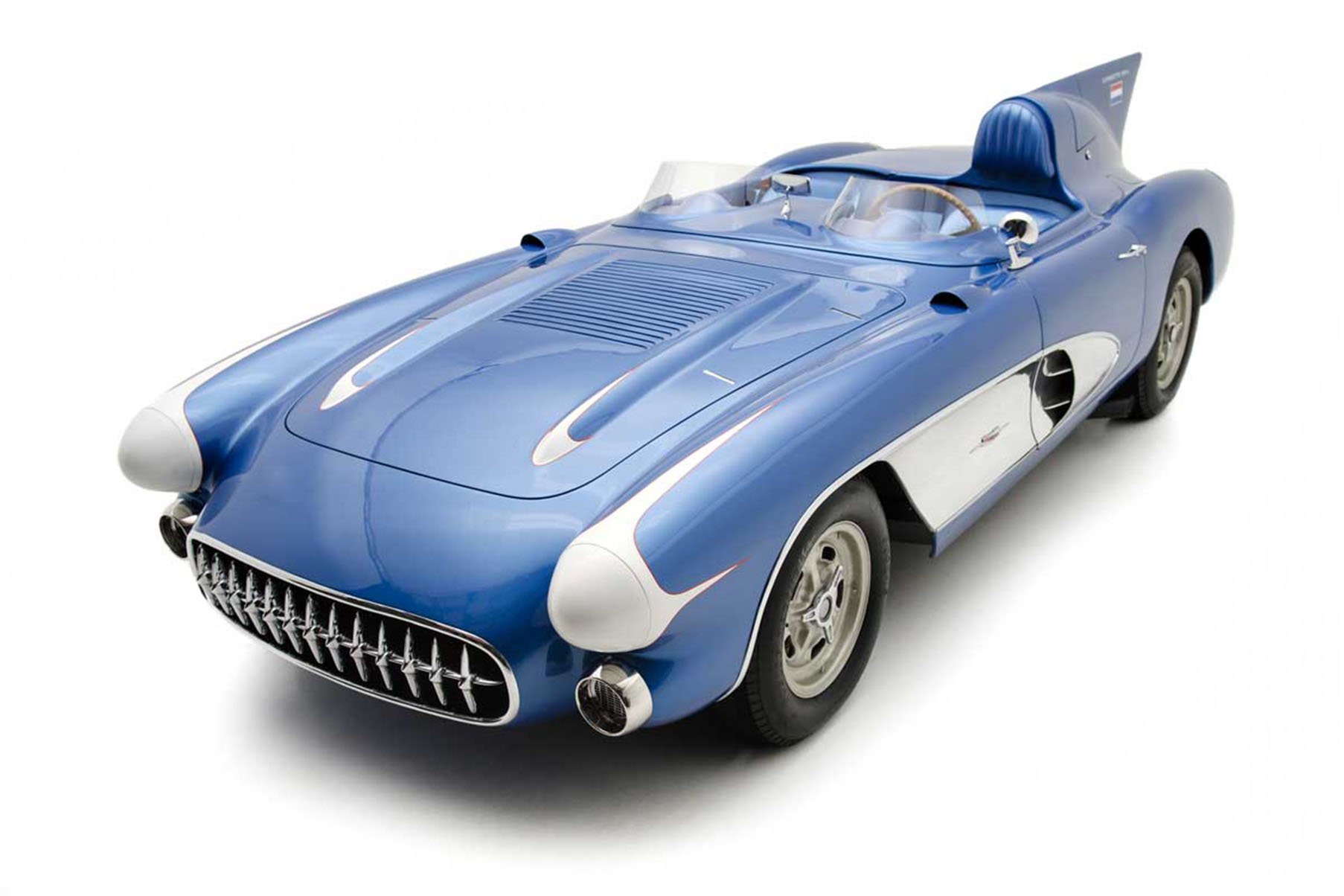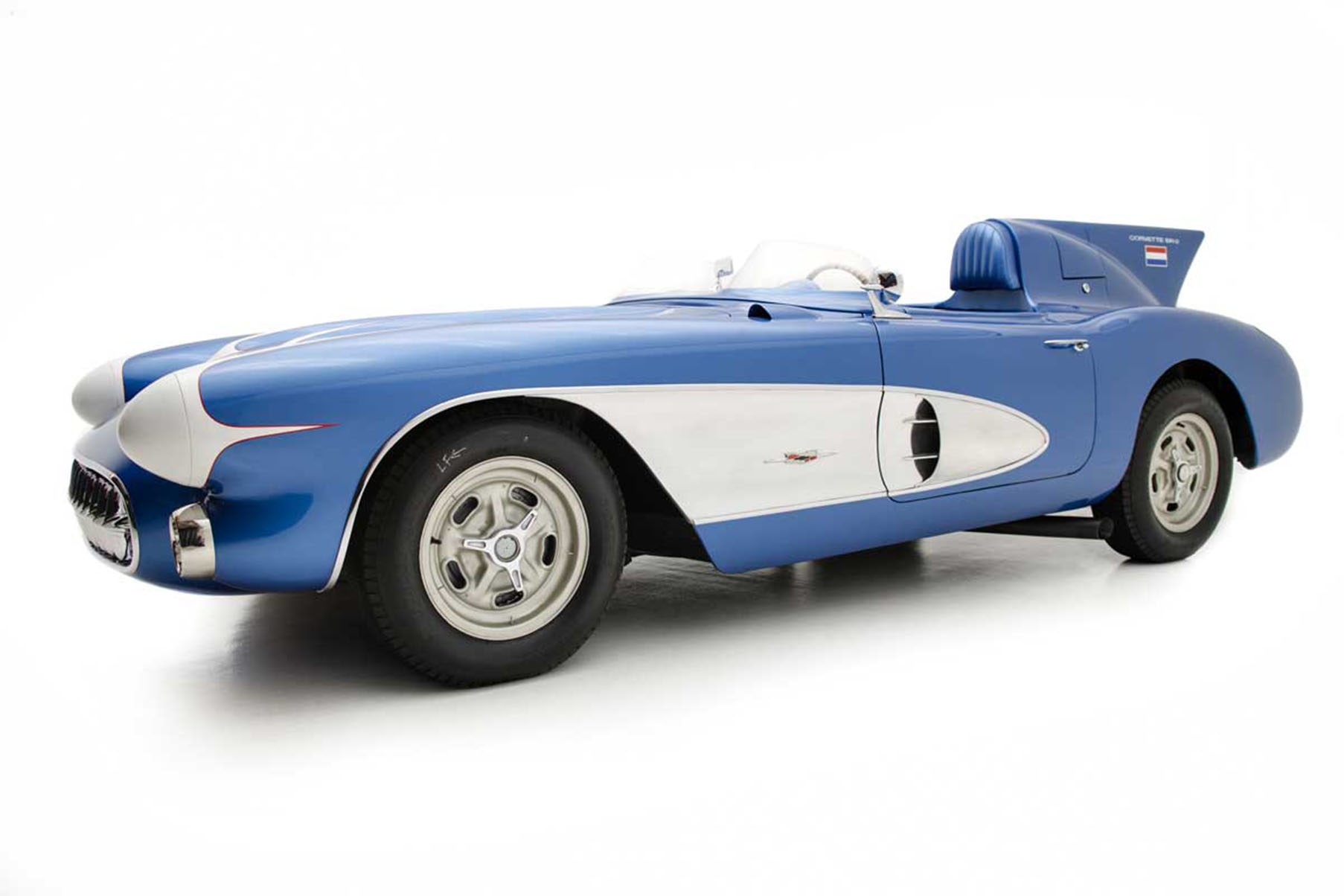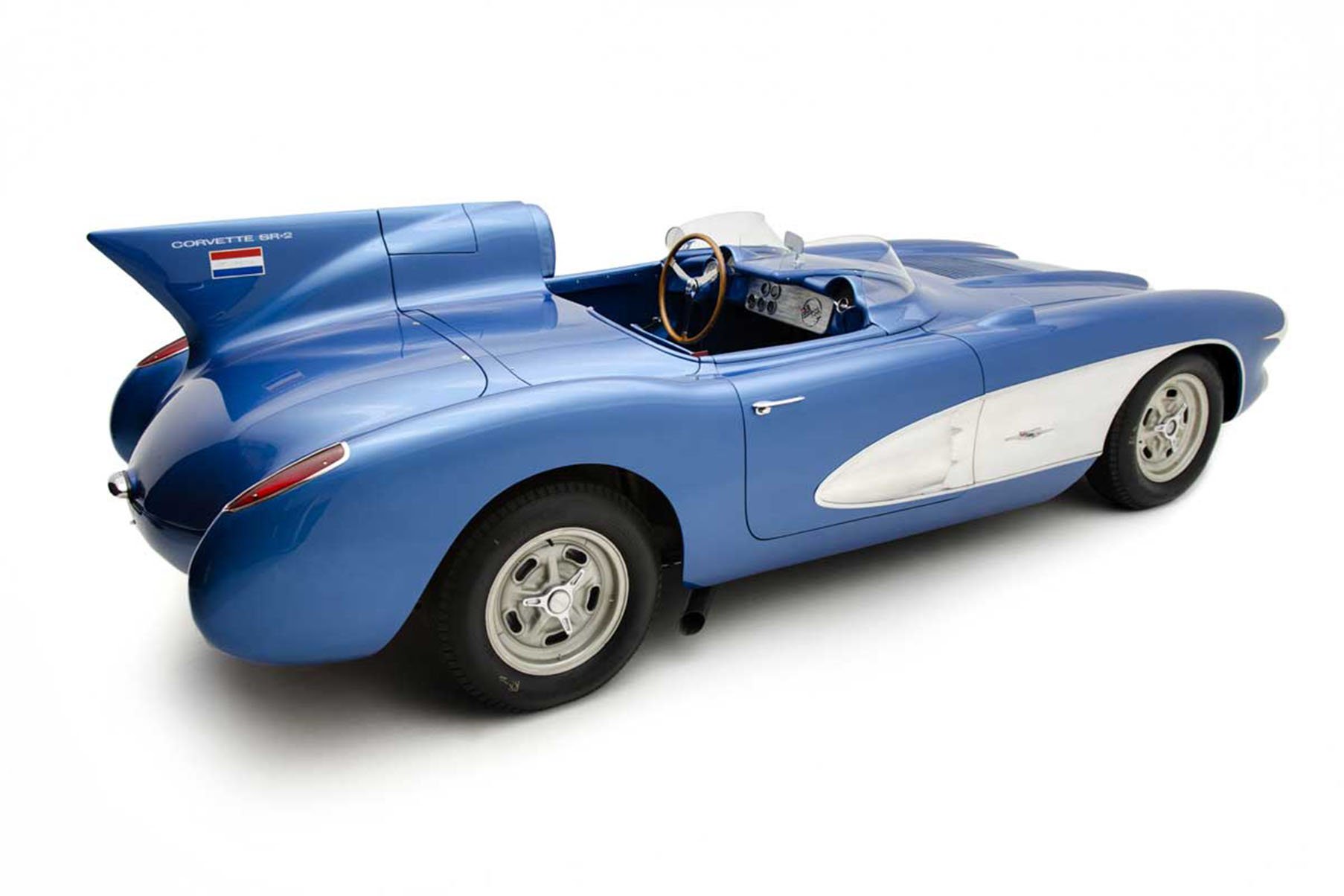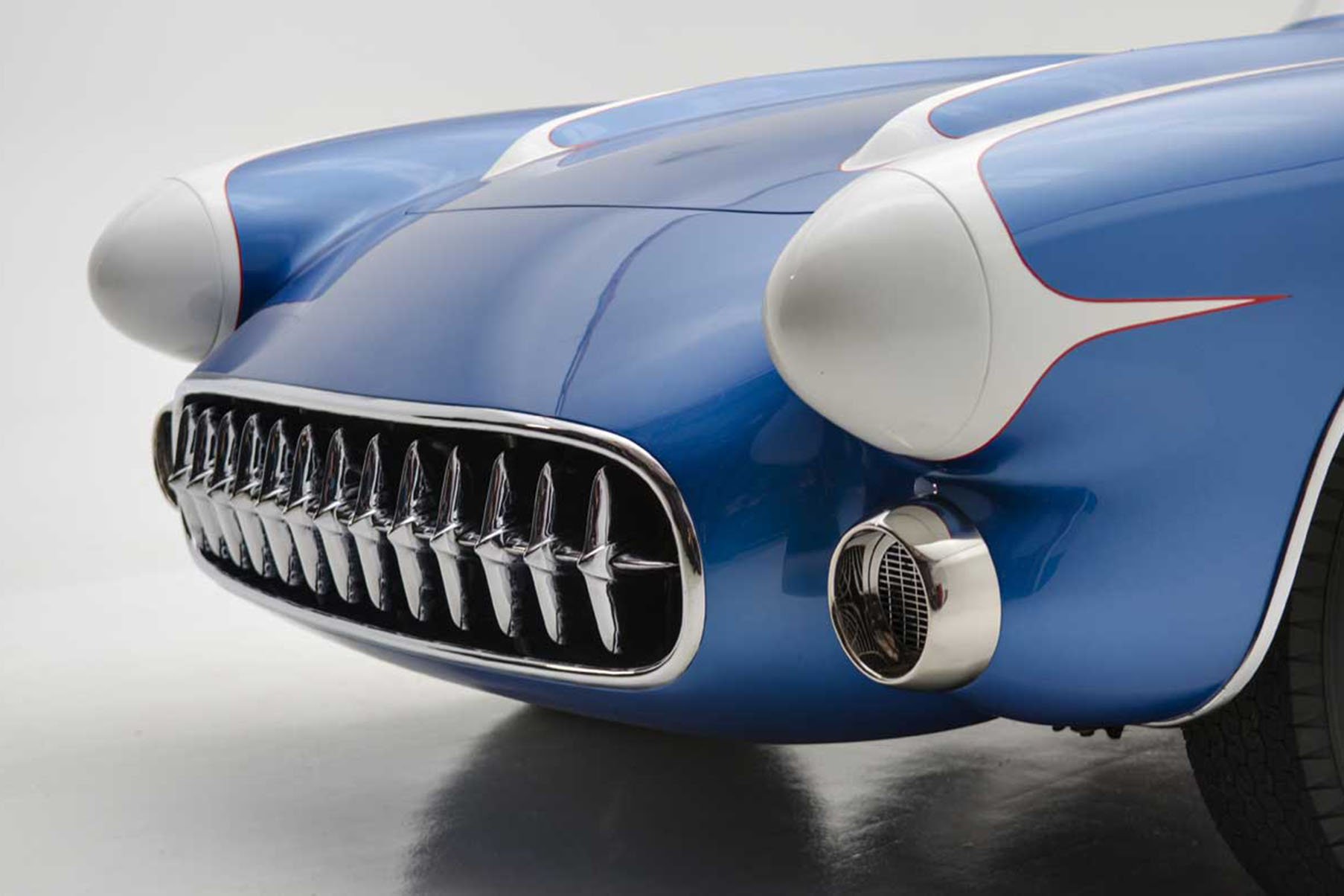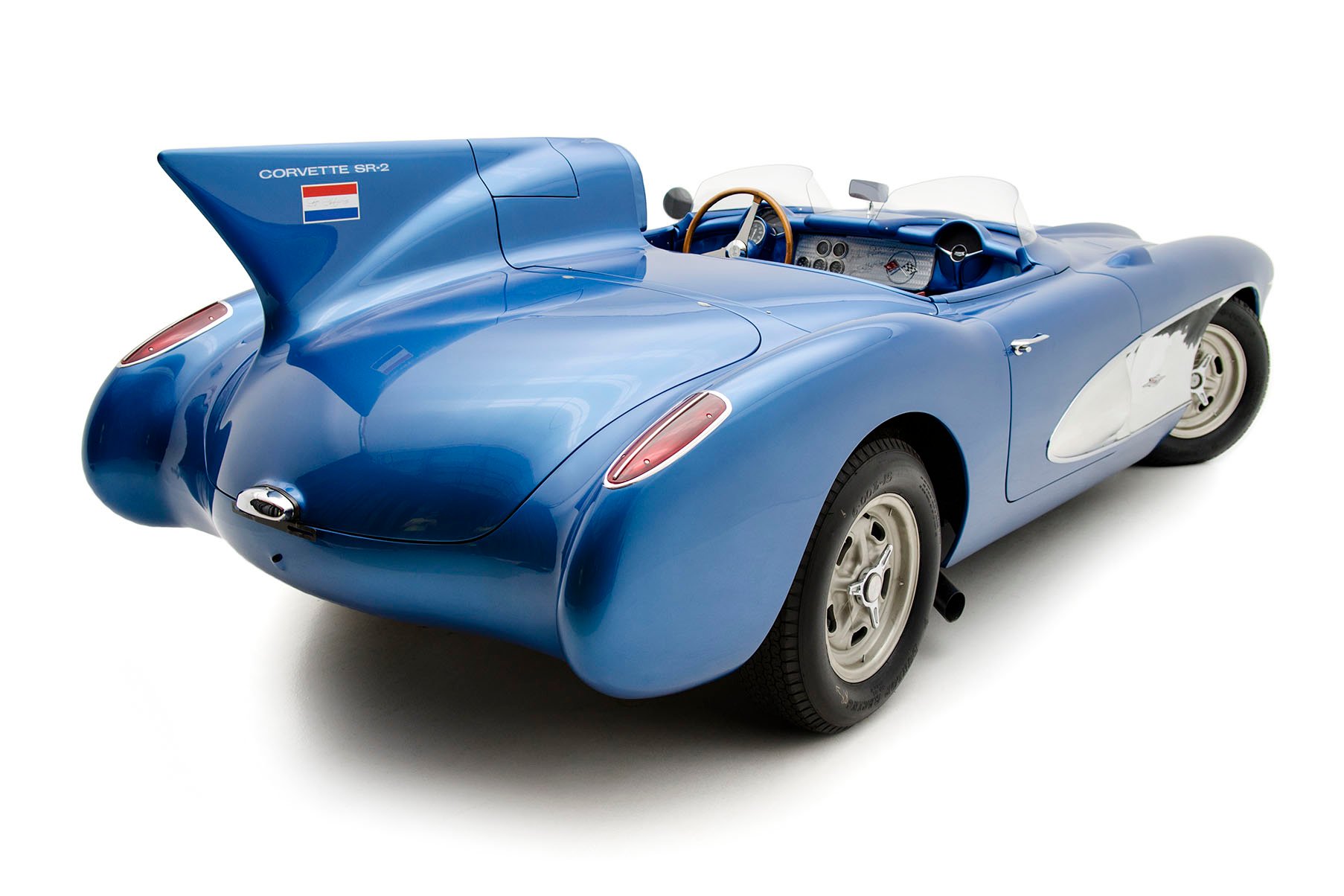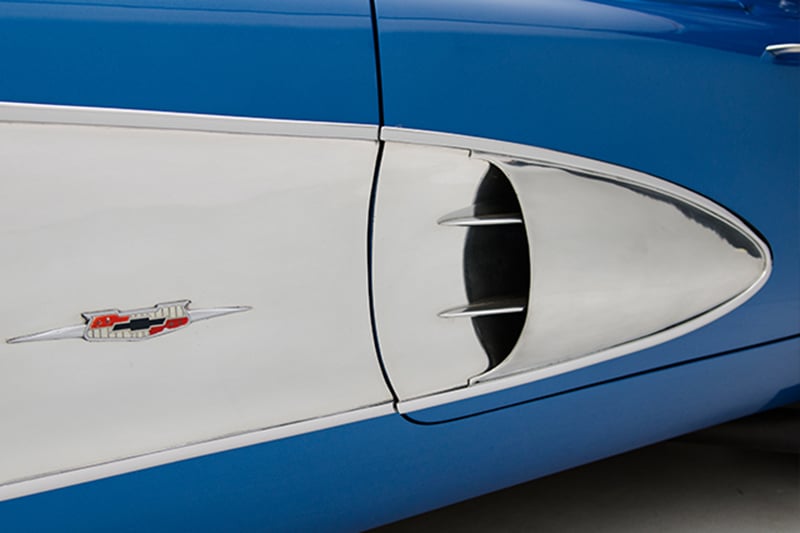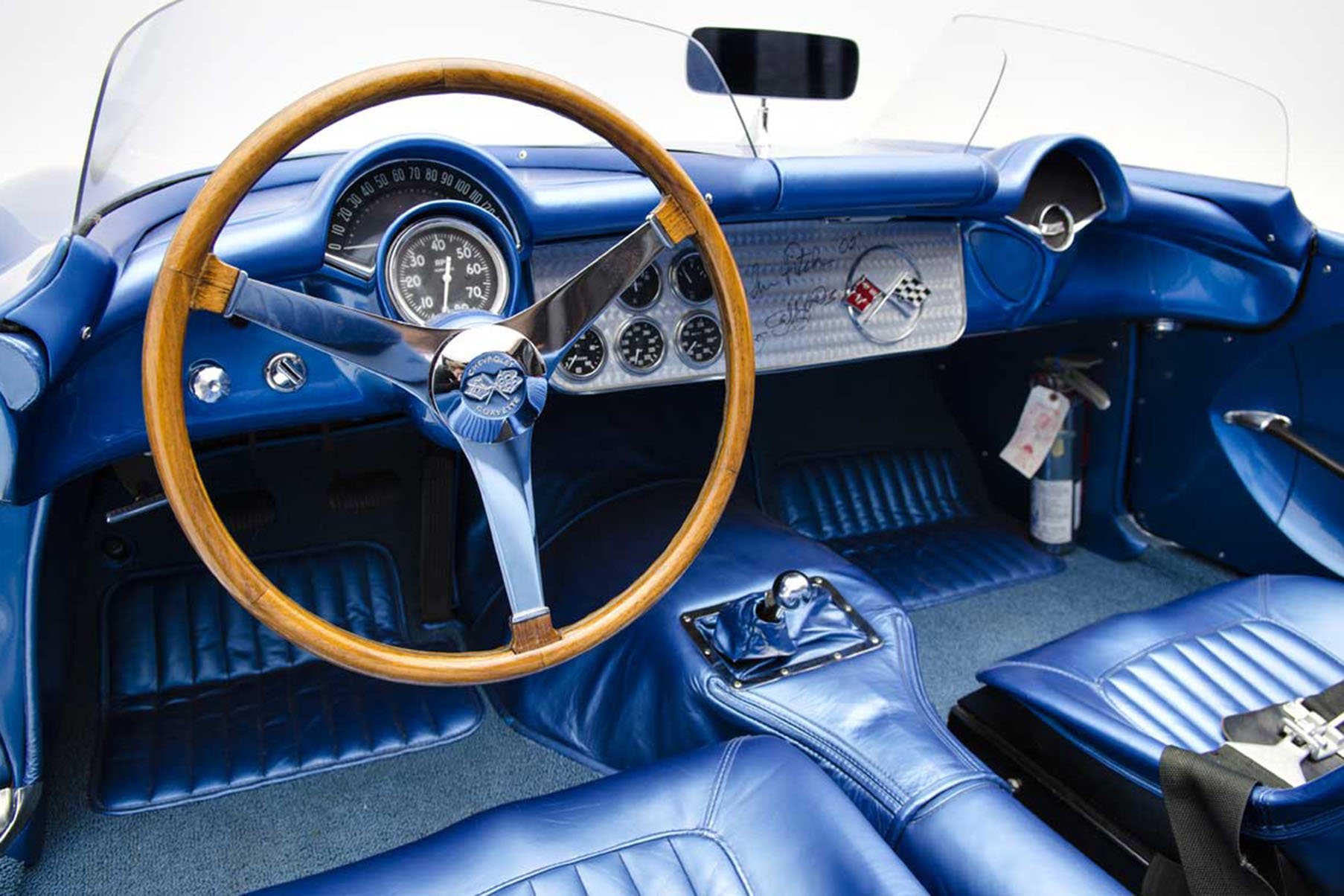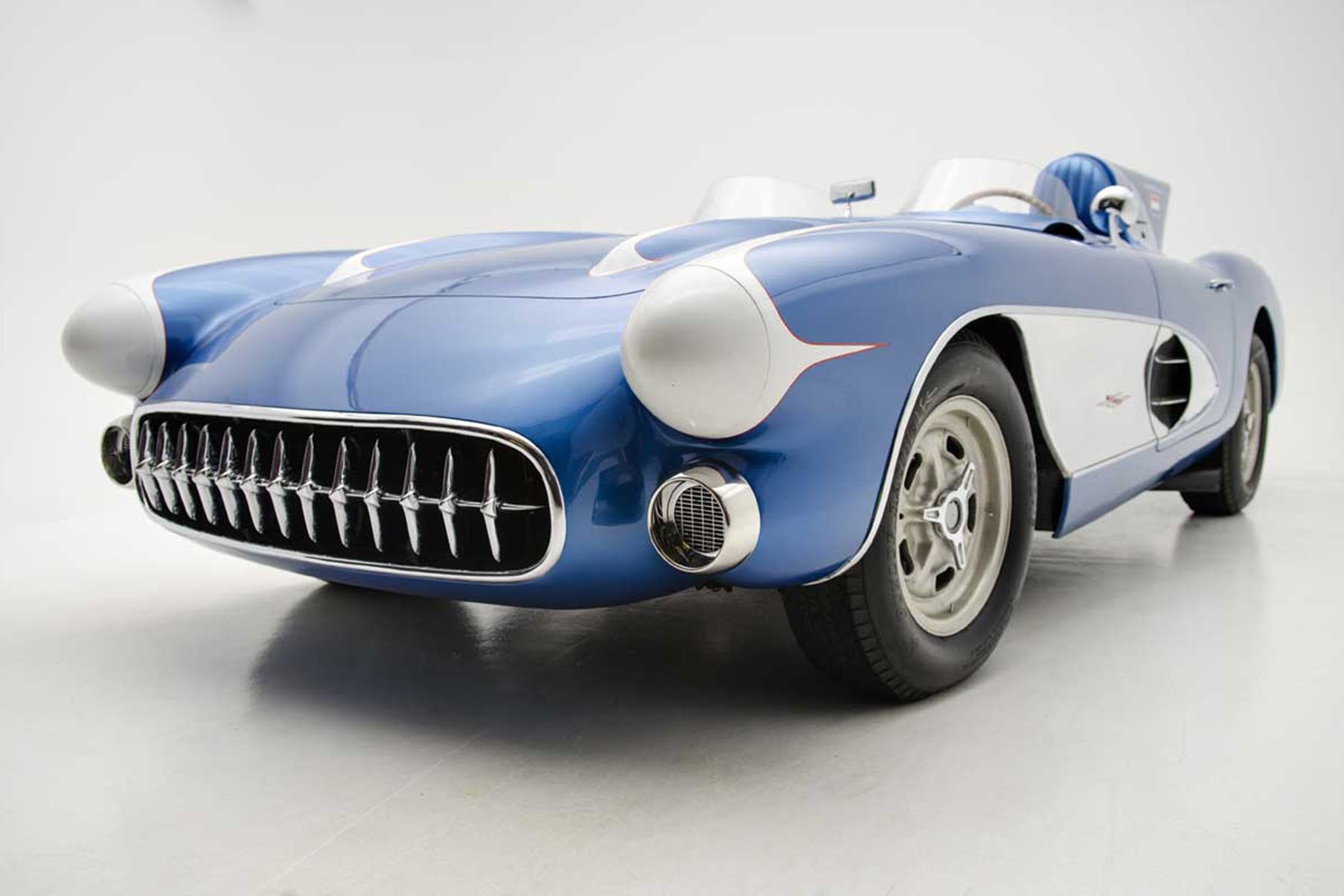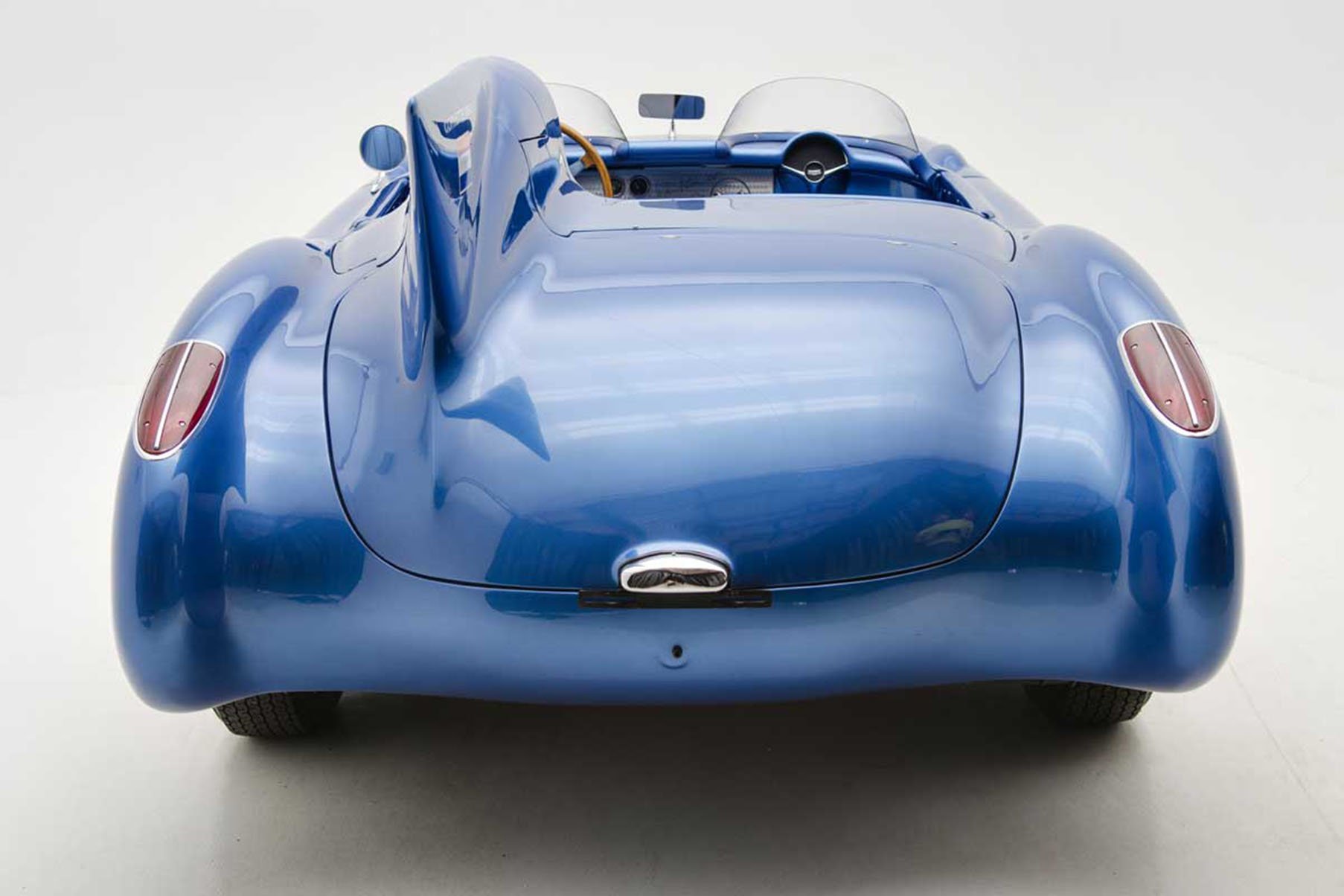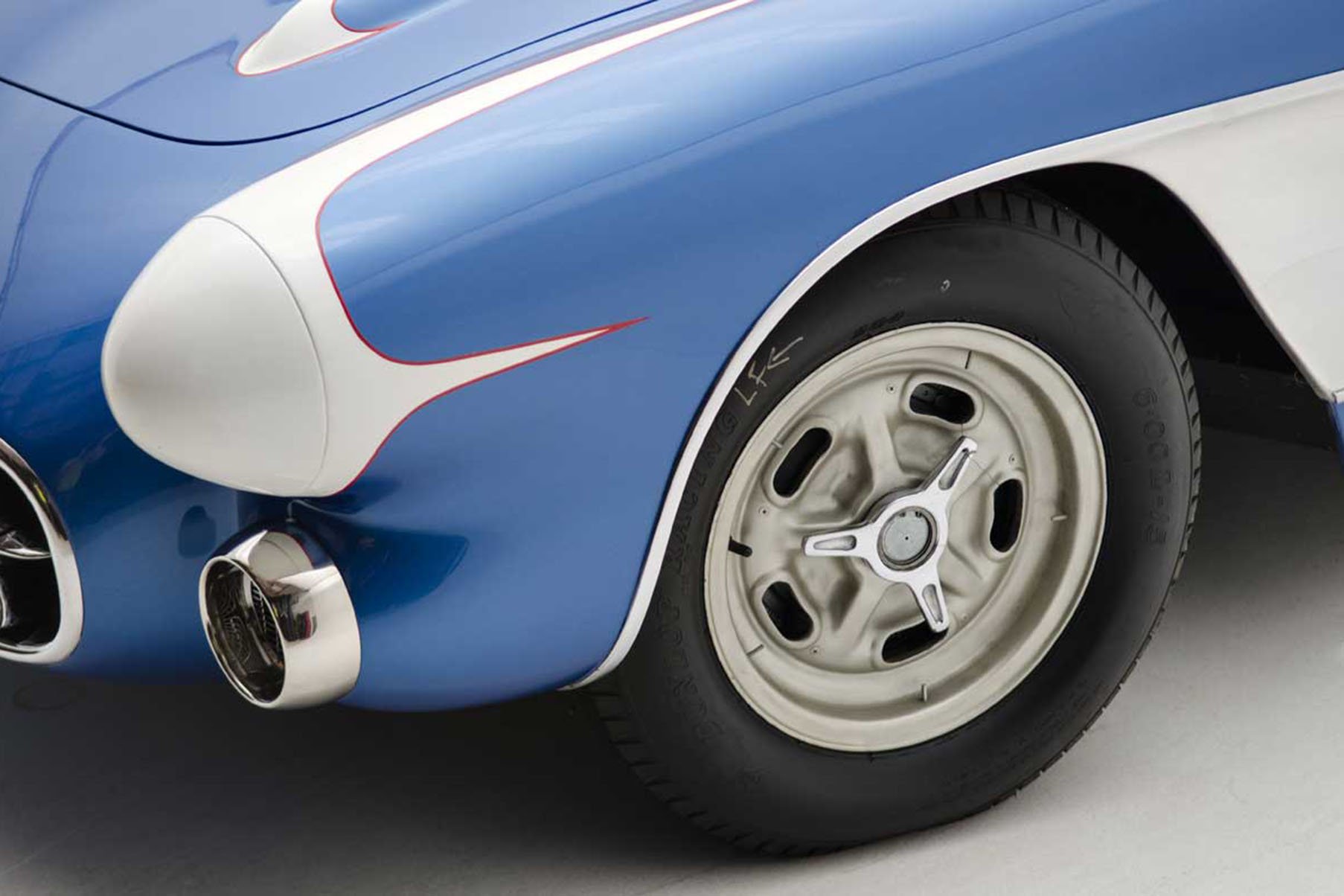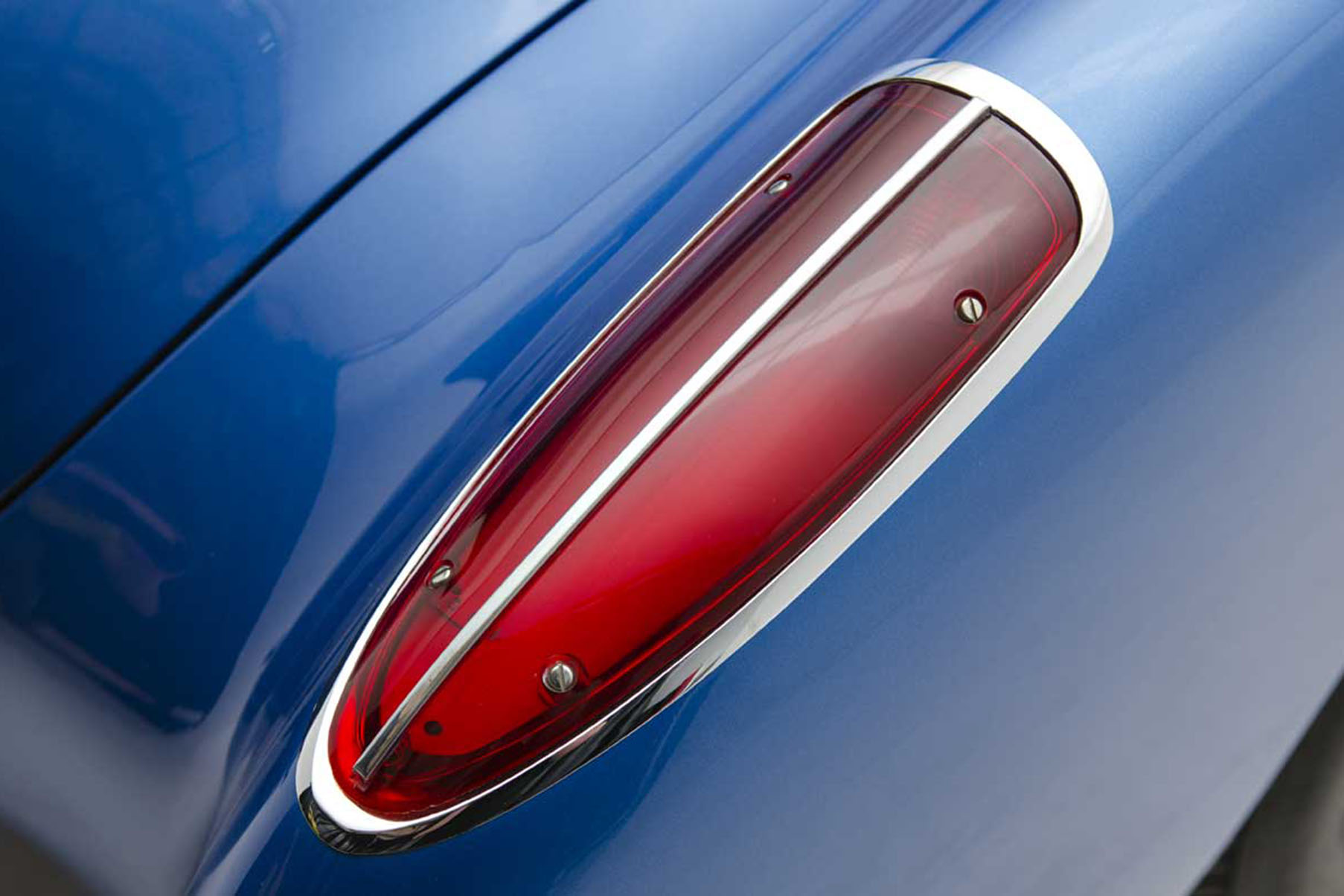Entering its fourth year of production and only its second time sporting available eight cylinder power, the Corvette had survived a shaky start that nearly spelled the demise of the model after just two years on the market. The Corvette avoided its meeting with the Grim Reaper due in no small part to the introduction of the Chevy small-block V8 as well as the desires of GM engineers Zora Arkus-Duntov and Ed Cole to reinvent Chevrolet as a youthful, performance-focused brand within General Motors, a sentiment shared by the GM brass.
In just a few weeks, a team of 17 engineers at Chevrolet transformed an off-the-shelf production 1956 Corvette into this, the SR-2 race car - or rather the first iteration of it, which used a smaller displacement motor, a lower, center-mounted rear fin and a slightly longer nose. Part of that feat can be attributed to another project in the works around the same time, the Corvette SS XP-64 concept car. Although the SS XP-64 was more of a one-off proof of concept engineering exercise that shared very little in common with the standard Corvette underneath the skin, some of its unique bodywork (like the low-drag windshield) could be ported over to the SR-2 with relatively little effort, which helped minimize the development time. Images: Corvette Mike
In the mid-1950s Jerome Earl, son of GM automotive designer Harvey Earl, was an avid road racer. However, in the SCCA classes he raced in he didn’t use a General Motors model, but rather a Ferrari.
As the legend goes, one day Cole called Earl into his office on a Monday morning and delivered the following: “I saw your son racing over the weekend. Why is he in a Ferrari? He should be racing a Corvette. Fix it.” And thus, GM’s internal racing program for the Corvette was born.
The SR Cars
By 1956 things were definitely on the upswing for the production Corvette. Along with newfound power from Chevy’s small-block and a three-speed gearbox replacing the decidedly lackluster two-speed Powerglide automatic as the standard transmission, the Corvette received a significant facelift that jived with its newfound athleticism.
Beginning in May of that year a team of engineers set to work designing a Corvette for competitive racing duty. Starting out life as a standard road-going 1956 production Corvette, example #2522 went straight from the St. Louis Plant where it was built to the GM Styling Studio in Warren, Michigan, for race modifications and cosmetic tweaks.
Between the 1956 and '57 SCCA race seasons, the team went back and made substantial changes to the SR-2. These included a shorter front clip, a larger rear fin mounted directly behind the driver (much like the Jaguar D-Type racer), a larger displacement small-block V8 (331ci) and additional weight reduction. Images: Corvette Mike
Bodywork modifications consisted of special low-drag windscreens for driver and passenger, while a low-slung, centrally mounted fin was added to the trunk. Stainless steel side coves were also added, the front end of the car lengthened, and the parking lamps were ditched in favor of cooling ducts for the Cerametalix drum brakes.
Under the hood was small-block V8, was initially fed by a pair of four-barrel carburetors. The GM team wasn’t happy with the setup though, and would later retrofit one of the earliest iterations of GM’s Rochester fuel injection system to the car (a setup that would soon make its way onto the road-going ’57 Corvette “Fuelie”).
The SR-2 ditched the production Corvette's parking lights and used the space for cooling ducts to keep brake temperatures in check. Out back they removed any unnecessary accouterments and added high speed stability by way of a large fin positioned behind the driver. Images: Corvette Mike
Incredibly, less than two months later the car was ready for its racing debut and was entered in the June Sprints at Road America in Elkhart Lake, Wisconsin. While driving the car during a practice session Jerry Earl would spin it, but thankfully no damage was caused. However, Dr. Dick Thompson would take the helm for the race itself.
After a middling but respectable performance in the six hour race, Thompson would report back that the car needed less weight and more power if it was going to contend with the best of Europe. The young Earl would continue to race the car in the SCCA’s central region through the rest of the 1956 season, but over the winter hiatus the team went back to the lab to make some significant changes.
To give the car more grunt, a special fuel injected 331 cubic-inch small block V8 was installed, and hooked to it was GM’s new four-speed manual gearbox. Weight also dropped by some 300 pounds by gutting the stock interior, adding light weight Porsche seats, and changing the door panels to light weight fiberglass pieces. The rear fin was also reshaped and positioned directly behind the driver, a la Jaguar D-Type.
 [11]
[11]After Dr Dick Thompson reported that the car needed more power to be truly competitive, the Chevy team dropped a special 331 cubic-inch small block into the engine bay. The SR-2 cars also served as development mules for production Corvettes to some degree as well, as they would utilize one of the earliest prototype versions of GM’s mechanical fuel injection system ever seen in public. Image: Corvette Mike
The SR-2 would also serve as something of a development mule for performance parts that would later find their way onto production Corvette option sheets, like the RPO (Regular Production Option) 684, a suspension package that consisted of higher rate springs (340 lbs/in at the front and 357 lbs/in. at the rear, up from 300 and 329, respectively), beefier sway bars, stiffer shocks and a quick-ratio steering box. Another performance option would also make its debut on the SR-2 race car: A trick new differential later referred to as Positraction.
Legacy
 [12]
[12]The Corvette SR-2 built for Bill Mitchell, then assistant to Harley Earl, was perhaps the most potent of the three SR-2 Corvettes built, as it was sent to tuner Henry “Smokey” Yunick for additional modification to both the drivetrain and the bodywork.
Just three SR-2 Corvettes would be built in total. Along with the one for Jerry Earl, another was constructed for GM’s Bill Mitchell. Coated in a red and white paint scheme, this car would see massaging from legendary tuner Smokey Yunick in the form of brake updates and additional weight reduction and would go on to post a top speed of 152.886 mph in the flying mile at Daytona Speedweeks in 1957 with Buck Baker at the helm.
A third car was also built. In contrast to the other purpose-built SR-2 racers, this one was used as a show car and featured wire wheels, a smaller rear fin, garden-variety Corvette production components and a stainless steel removable hard top.
 [13]
[13]The third Corvette SR-2 built differed significantly from the other two, as it was designed to be a show car rather than a racer. As such, it utilized standard production Corvette mechanicals and featured wire wheels, a stainless steel removable hard top, and a smaller, center-mounted rear fin. Image: Flickriver
After being sold off to Jim Jeffords following the 1957 race season, the original SR-2 Corvette prepared for Jerry Earl would go on to see its greatest racing success in the SCCA’s B-Production series, where Jeffords would take home the championship in 1958.
Today, that SR-2 Corvette sits alongside the original Corvette Grand Sports as one of the most sought-after Corvettes in the model’s history, and was offered up for sale by Corvette Mike in 2015 for the hefty sum of $6.885 million.
Today the original SR-2 cars are some of the most valuable and lusted-after collector Corvettes that exist today. The original car built for Jerry Earl, seen here, was offered up for sale by Corvette Mike in 2015 for nearly seven million dollars. That puts it in the same company as the original Grand Sport Corvettes in terms of value, though the current worth of an original GS is hard to determine. Rumors suggest a recent offer of $12 million for one of the five built was turned down. Images: Corvette Mike
Its allure goes well beyond its head turning looks and successes on the race track, as it stands as a testament to a turning point in the Corvette’s evolution from a sharp looking runabout into a sports car that could compete – and win – at the highest levels of motorsport, a tradition which continues to this day.

